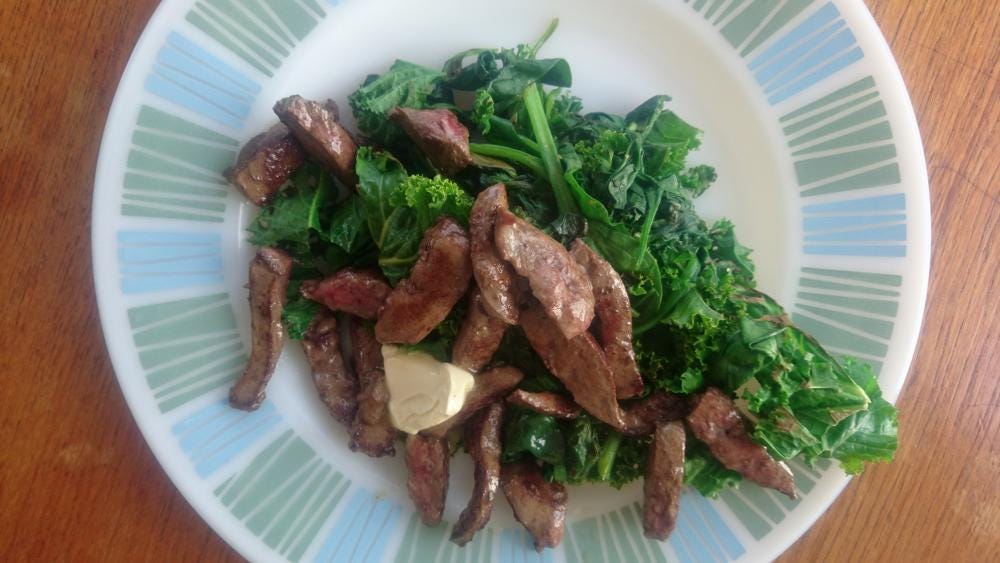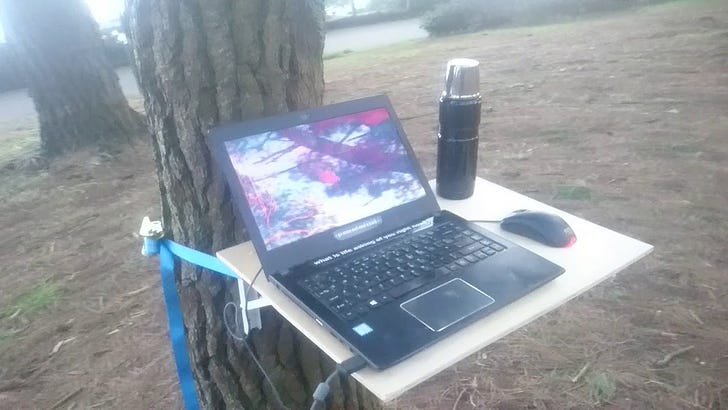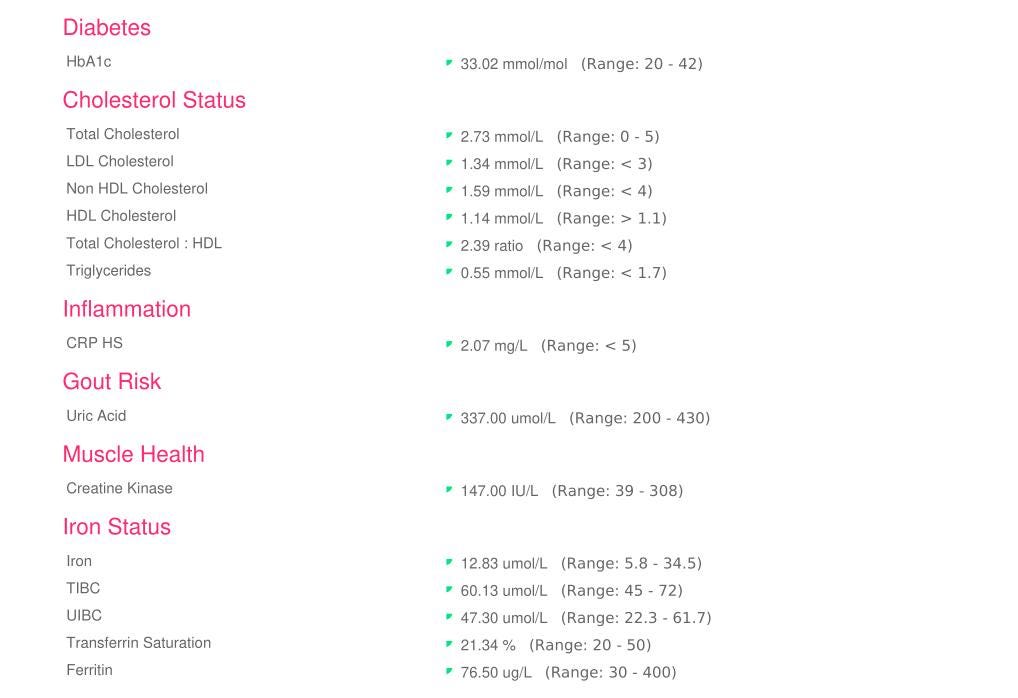How vital is my vegan blood?
This week: lucky numbers, tree desks, vegan blood test results and emergency carrots
Happy Friday!
And welcome to edition 259—coincidentally the forty-ninth lucky number, mathematically speaking. Other lucky numbers include the famously unlucky 111, 87 and 13.
There are many spurious, non-mathematical, reasons why 13 is considered unlucky, but my favourite explanation is that there are actually 13 months in the year, not the 12 that you see on patriarchal calendars the world over. I was pondering this anomaly in the shower the other day. Why does poor old February only have 28 or 29 days when no other month has less than 30 and plenty stretch out to 31?
As my skin gradually shrivelled in the stream of water, I unilaterally decided that we should club together to snip a day off both March and August and graft them on to the end of February, which would become a 30-day month—31 days on leap years. February has been too short for too long!
But then, nudging the hot tap a little hotter, I thought: why not simply have thirteen 28-day months?
Yes, I know that adds up to only 364 days: the day (or two on leap years) would be a very special monthless day plopped in somewhere between Christmas and New Year—don’t worry, everyone will be too drunk to notice.
Secretly, we all love February being so short—so why not divide all the months into dependable four week blocks and treat ourselves to a thirteenth? If you like, we could call it Davember. Or Charlesuary.
Yes, yes, I agreed with myself, as I idly pushed soap around my armpits—thirteen months would be much easier to get our heads around. The first day of the month would always be a Monday, my birthday would always be a Sunday, and we would never again suffer the nightmare of Friday the 13th.
Assuming a median menstrual cycle, you would ovulate on the same day every month—imagine! But therein lies the conspiracy theory.
In ancient times, you see, the Mother Goddess was in charge and, understandably, she was big into menstrual cycles. Back in the day, thirteen was very much her lucky number. Then, one portentous Tuesday, sometime after lunch, The Patriarchy Ltd. launched a hostile takeover and declared menstrual cycles taboo, along with the matriarchal concept of thirteen months in a year.
It was then that I noticed I’d been standing on the plug hole and that hot water was overflowing into the bathroom. I hope your luck is in today.
Now, on with the show!
What me and my body have learned from 324 days of isolation veganism—including blood tests
Does veganism make you anaemic? Boost your testosterone? Make you B12 deficient? Lower your cholesterol?
It’s been almost a year since I decided to give veganism a try, so last week I bought myself a late Christmas present: a battery of blood tests covering 58 different biomarkers. Not everyone’s idea of fun, but, as a self-confessed data freak, definitely one of mine.
If you’ve ever been curious about what veganism does to an otherwise healthy 38 year old male with Hashimoto’s hypothyroidism, then, boy, are you in for a treat!
Step One: Finding dietary deficiencies
For the two weeks leading up to my blood tests, I also tracked my diet using a web app called Cronometer. It’s got a huge database of different foodstuffs—yes, including maca powder and pea protein—and you can create your own recipes. As easy as it is to use, however, I really can’t be bothered to do it for more than two weeks.
This is what I learned about my current vegan diet.
Don’t be shy to add protein
Without the meat-eaters carnal reflex, vegans can get distracted by the delicious rainbow of vegetables and end up eating less protein than they need. This was something a perspicacious friend noticed after my diet swerved to consist of nothing but incredible curries from Meera Sodha’s Fresh India.
In response to the data, I’m now drinking the odd protein smoothie for breakfast, particularly on days when I do press ups and kettlebell swings. Depending on the exact recipe, that gives me at least 45g of protein before I’ve even started the day.
Tofu and tempeh, beans and lentils are other popular vegan sources of protein and easily added to any recipe that’s otherwise missing that particular macronutrient. Other easy tweaks include exchanging white rice for British quinoa and preparing a 100g bowl of nuts and seeds to graze on through the day.
It’s worth noting that these vegan sources of protein cost 2-5p per gram of protein, a similar range as meat proteins (beef mince costs 2p/g; chicken breast 3p/g; beef steak 5p/g). Tempeh can cost a little more—my source is 7p per gram—but it’s delicious so I’m happy with that.
I have also dabbled with textured vegetable protein (TVP) and even defatted peanut flour—both much tastier than they sound and both excellent value for money at only 1p per gram of protein.
Eat these superfoods every day
One very cool thing about Cronometer is that it gives you a breakdown of where you’re getting your various nutrients from. That means you can easily discover your own personal superfoods: those foods that you should eat every day to make sure you’re getting the full spectrum of vitamins and minerals without having to resort to supplements.
For me, tahina is a superfood. It’s high in Omega-6, iron, saturated fats, vitamin B1, calcium, selenium, manganese and zinc, as well as protein. Plus it’s easy to hide in a meal or spread on toast or tortillas.
Flax, chia and hemp seeds are also superfoods for me. They’re high in Omega-3, vitamin K, manganese, zinc, selenium, magnesium, iron, vitamin B1, as well as protein. I can mix 15-20g of each into my morning oats or into a protein smoothie. Seeds are also a big part of my Bread of Life recipe.
A colourful daily salad is also a superfood, made up of vitamin-rich yellow, red and green leafy vegetables (kale, spinach, okra). However: a daily salad is also a bit of a faff. If it’s too much of a faff (and recently I confess it has been) then I can downgrade this to an emergency carrot, which makes sure I get enough vitamin A so that I can see in the dark.
Another red flag in my Cronometer data is calcium. On only one day in the past fortnight have I managed to hit 100 percent of my recommended daily allowance. That was Pancake Day because I used a fortified oat milk to fuel my flipping overdose. I really should be eating green leafy vegetables like kale, spinach and okra every day. Or, when I’m thrill-seeking, dried figs.
Dr Greger’s savoury blend of ten different spices is also worth a mention in the superfoods column. One teaspoon offers a neat little dose of B vitamins, vitamin K and zinc—and will bring the zing to any lifeless snack.
Finally: nuts. A wee bowl of mixed nuts is fabulous for B vitamins, vitamin E, iron, magnesium, manganese, zinc and the full spread of amino acids. Brazil nuts deserve a special shout out for giving me all the selenium I could ever dream of, as well as a dose of that easily-overlooked calcium.
Vitamin supplements
As a vegan, the Cronometer data confirmed that I must supplement with Vitamin B12 and Vitamin D. Simple as that. I also take a daily multivitamin, which covers all bases, just in case.
More interestingly, I have also been taking a creatine supplement of about 3-5g per day. Creatine is an amino acid found only in meat muscle and is great for intense exercise and building testosterone.
Step Two: What does the blood say?
Now comes the part you’ve all been waiting for: the results of those 58 blood tests.
Drum roll, please… Ta-dah!
I don’t want to blind you with data, so here’s a very brief summary of what the blood told me:
I’ve been ill recently: my immune system was stressed.
I have a thyroid autoimmune disease. Nice to know that the NHS hasn’t been gaslighting me all these years.
Otherwise: all good! That is to say: the remaining 56 biomarkers were all within the normal range.
It turns out that, after almost a year of veganism, I have a healthy liver and kidneys, healthy levels of inflammation, protein and vitamin D. My cholesterol profile is ‘excellent’ and I don’t have diabetes or gout. My homones, including testosterone, are also completely fine.
Side story: Normal testosterone reference levels are different between the UK and the US. Apparently, testosterone has been falling in men for decades and, rather than untangle the environmental factors that may be behind this—stress, noise, pollution, antibiotics—medical scientists have instead been revising down their definition of ‘normal’. This is called shifting baseline syndrome and is also the reason why, as generation cedes to generation, we have been gradually downgrading our expectation of the number of songbirds in our garden. For example.
However: the doctor who interpreted the tests for me did mention that my B12 levels were on the low side. He recommended that I take a further test to check for any underlying problems, such as pernicious anaemia, which is fairly common in patients with Hashimoto’s hypothyroidism.
Then, when I shared my results on a semi-reputable Hashimoto’s internet forum, someone stepped in to tell me that my iron levels were also pretty low for a man. Apparently, people with autoimmune conditions like Hashimoto’s can have trouble absorbing nutrients like B12 and iron. All the more reason to stuff down that kale.
Step Three: What about my day-to-day feels?
It’s all very well analysing dietary and blood data, but what about my day-to-day feels?
Obviously, the past year has been WEIRD. Pandemic isolation was one of the main logistical reasons why I was able to make the leap to veganism in the first place, but the accompanying onslaught of weirdness is also a confounding factor when trying to decide whether I’ve felt stronger in mind and body since changing my diet.
Bearing that in mind, in short, I don’t think I feel any different. I don’t feel awful, but nor do I feel superhuman. And I think I’m still just as much of a hypochondriac as I was before—you can imagine my delight when I saw that the blood tests supported my assertion that I’ve been feeling run down over the past few months.
One thing that has definitely been a huge improvement since going vegan is how much more fun I’m having in the kitchen. As I mentioned earlier, the gift of recipe book Fresh India pretty much changed my eating life. I’ve also really got into baking bread, including tortillas and naans. Veganism has helped me enjoy making an effort—even when that effort is waiting three weeks for kimchi that would last only a weekend.
However, I’m not the only person in the world who has, over the past year, been forced to familiarise themselves with the interior life of hearth and home. If it wasn’t for my whimsical experiment with isolation veganism, would I perhaps be writing to you today about the wonders of knitting? We will never know. But it’s lunchtime now and I’ve got a loaf in the oven—bon appétit!
BREAKING NEWS
I have decided to experiment with a dietary change even more radical than eating more kale. Yesterday, I bought and ate 90g of Dorset lamb liver. Yes, I know what you’re thinking: yuck. Also: that’s not vegan. Both excellent observations.
The problem is that there are no wholefood vegan sources of B12. All vegans can do is eat supplements, either in pill-form or in fortified processed food. Even then, I’d need to eat 31 teaspoons of B12-enriched yeast flakes or an entire jar of Marmite to match what I’d get from one serving of liver.
Lamb liver is extraordinarily high in B12 and iron. According to Cronometer, that one portion of lamb liver gave me 2,868 percent of my daily allowance of B12, as well as 93 percent of my iron. Take that, poor absorption!

After reading Spoon-Fed, epidemiologist Tim Spector’s most recent book, I am prepared to at least entertain the idea that eating meat might be better for my body than eating pills.
Side note: I’m pretty sure that eating meat will be worse for the environment, but I am slightly comforted by the thought that the lambs lived very locally and that no one else will eat the liver anyway. Maybe?
B12 is water-soluble and the body doesn’t store much in reserve, which means that I need to get enough B12 in my diet every single day. My liver-vegan experiment will run for the next two months and I intend to eat one portion of lamb liver every week, split over three meals, take high strength B vitamin supplements every day, and continue to add a teaspoon of B12-enriched yeast flakes to my food.
At the beginning of May, I’ll test my levels of B12 and iron again and see what, if anything, has changed.
Rumours circulating on the Hashimoto’s forums indicate that this all-guns-blazing intervention might raise my B12 and iron to the point where I can drop the liver and return to a normal vegan diet. We shall see.
~
If you’re curious, I got the Ultimate Performance blood test from Medichecks. It’s usually £200, but often discounted. I got mine for £180, including an appointment with a nurse to take the blood.
Any more for any more?
‘Wartime’ investment in carbon capture must start now, researchers say
My latest article for the Global Landscape Forum is based on a fascinating study that modelled what could be possible if we treated the climate crisis like an actual crisis. In other words: What could wartime levels of emergency funding buy us in the fight against global warming?
TL;DR: negative emissions technologies (NETs) have the potential to help us meet the Paris Agreement targets, but massive investment in research and development (like 2 percent of GDP) must start now. Even then, NETs will only supplement, not substitute, far-reaching decarbonisation of the economy.
Practice and Suck Less
Foiled
Remember to catch the last EVER BBC Radio series of Foiled on BBC Sounds.
Episode 1 with Garnon Davies as Tonypandy’s local baguettes kingpin has already disappeared!
Episode 4 with Kiell Smith-Bynoe as Mike the karaoke booth manager
Right, that’s all for now, chickens. This afternoon, I’m interviewing a woman about climate conscious cryptocurrencies and then having a meeting about a theatrical future of Foiled… Watch this screen!
I’m also hoping to run a marathon this weekend. Not all in one go, obviously—that’d be madness. Inspired by David Goggins, I’m doing a lightweight version of his 4x4x48 ultramarathon fundraiser. Lightweight in two ways: a) I’m doing 42km, not 48 miles and b) I’m not fundraising either. Thanks for the idea, JG!
Big love,
dc:
CREDITS
Hello, I’m David Charles and I’m a UK-based writer and outdoor instructor. Say hello by replying to this email, or delve into 500+ other articles on davidcharles.info.
11 percent funded ▲▲△△△△△△△△△△△△△△△△△△
These free weekly emails are supported by readers who scroll all the way to the bottom—readers like you 😁 Help unlock the commons by becoming a paying subscriber for £30 per year—about 58p per newsletter. To say thanks, I’ll send you a book!




